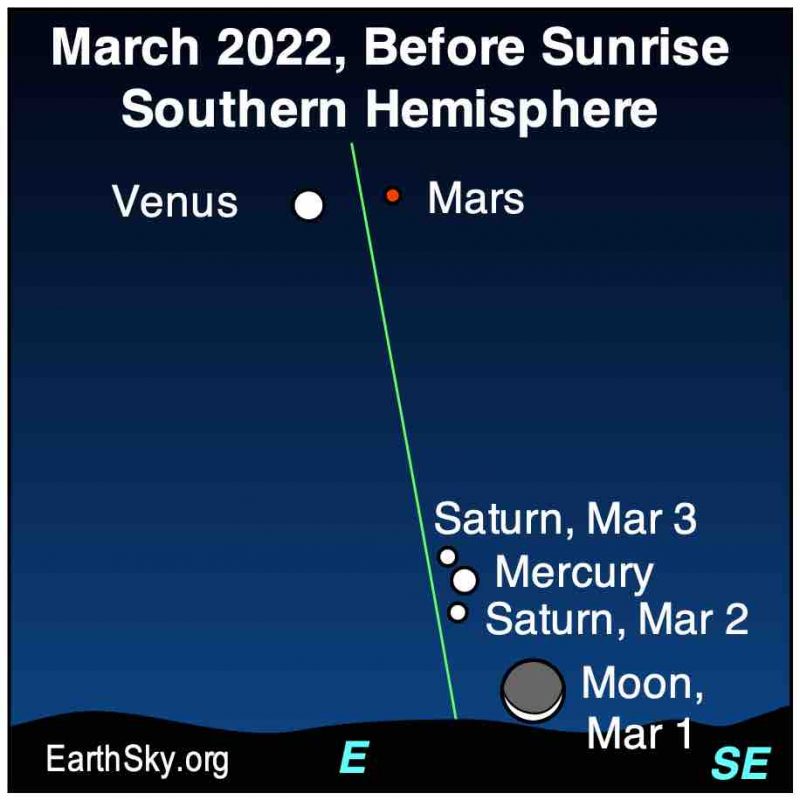
Mercury and Saturn at dawn
Only about 12% of the world’s population lives in the Southern Hemisphere. So they’ll be the lucky few who get to see four planets before sunrise in early March 2022. Venus and Mars have been visible to observers around the globe since last month. And many Northern Hemisphere observers saw Mercury climbing toward Venus and Mars as it edged up toward its greatest elongation in mid-February. In late February and early March, Mercury is sliding back toward the horizon. It’s perhaps already slid out of view for you, if you’re a Northern Hemisphere skywatcher. But – whether you can see it or not – Mercury will meet up with Saturn around March 3. Southern Hemisphere skywatchers will have a good chance to see this meeting. And even the moon joins the view on March 1, for a picture-perfect grouping.
Each morning, Mercury is brightening as it drops closer to the eastern horizon. On March 3, Saturn and Mercury will be side by side in right ascension (like longitude on the sky’s dome). That is, they’ll be in conjunction, and less than one degree apart. If you hold your pinky finger out at arm’s length, both the planets could hide behind it.
Mercury will appear as the brighter of the two planets, at magnitude -0.1. Saturn will be shining at 0.8.
Of course, Venus, above with Mars, is radiant and outshines them all. It’s at magnitude -4.5 while Mars is magnitude 1.2.
Try using binoculars to investigate these very different worlds.
Shifting planets
After Saturn and Mercury’s close pairing on March 3, Mercury will drop closer and closer to the sun, getting lost to observers around March 18. Meanwhile, Saturn climbs upward in the eastern predawn sky. Soon, we in the Northern Hemisphere will be able to see it, too. Saturn will join Venus, Mars and the moon for a beautiful conjunction in late March.
If you’re in the Northern Hemisphere and want to try to spot Mercury and Saturn, you can give it a shot. There’s just no guarantee you’ll see them against the bright dawn twilight. Why are the Northern and Southern Hemisphere views so different? As usual, it’s the ecliptic – or path of the sun, moon and planets – that’s the culprit. The angle of the ecliptic with the horizon is shallow for the Northern Hemisphere now, in the hour before dawn. So, from this hemisphere, Saturn and Mercury will be ascending in the bright twilight near the eastern predawn horizon.
You’ll have Venus and Mars as consolation prizes, though. And beautiful ones they are!
If you capture a great photo of the planets at daybreak, submit it to us!
Bottom line: Observers in the Southern Hemisphere have a chance to spot Mercury and Saturn before sunrise in early March, below bright Venus and reddish Mars. Northern Hemisphere observers will likely see only Venus and Mars (not Mercury or Saturn).
Read about this month’s planets and more
The post Mercury and Saturn, Southern Hemisphere, early March first appeared on EarthSky.
0 Commentaires